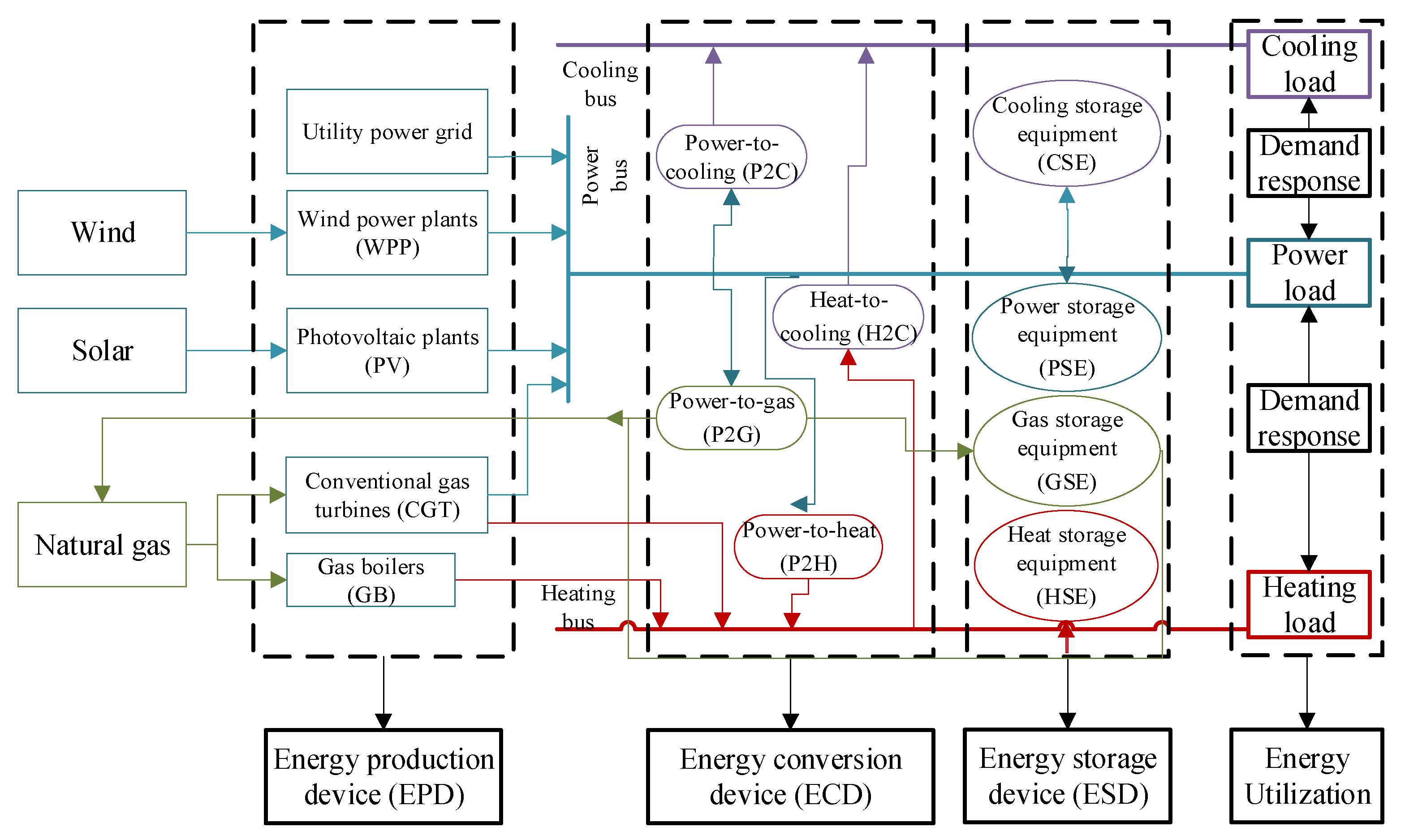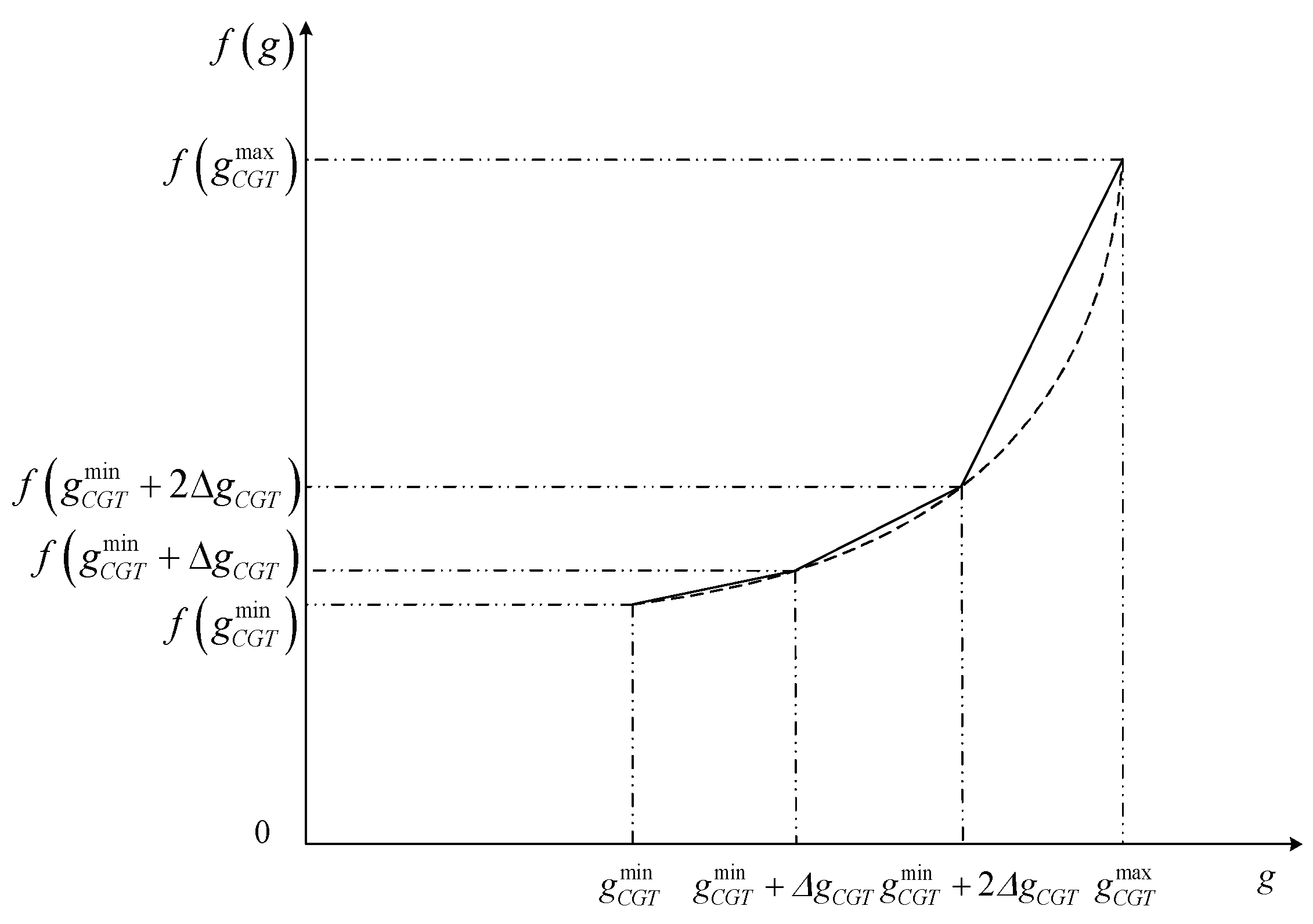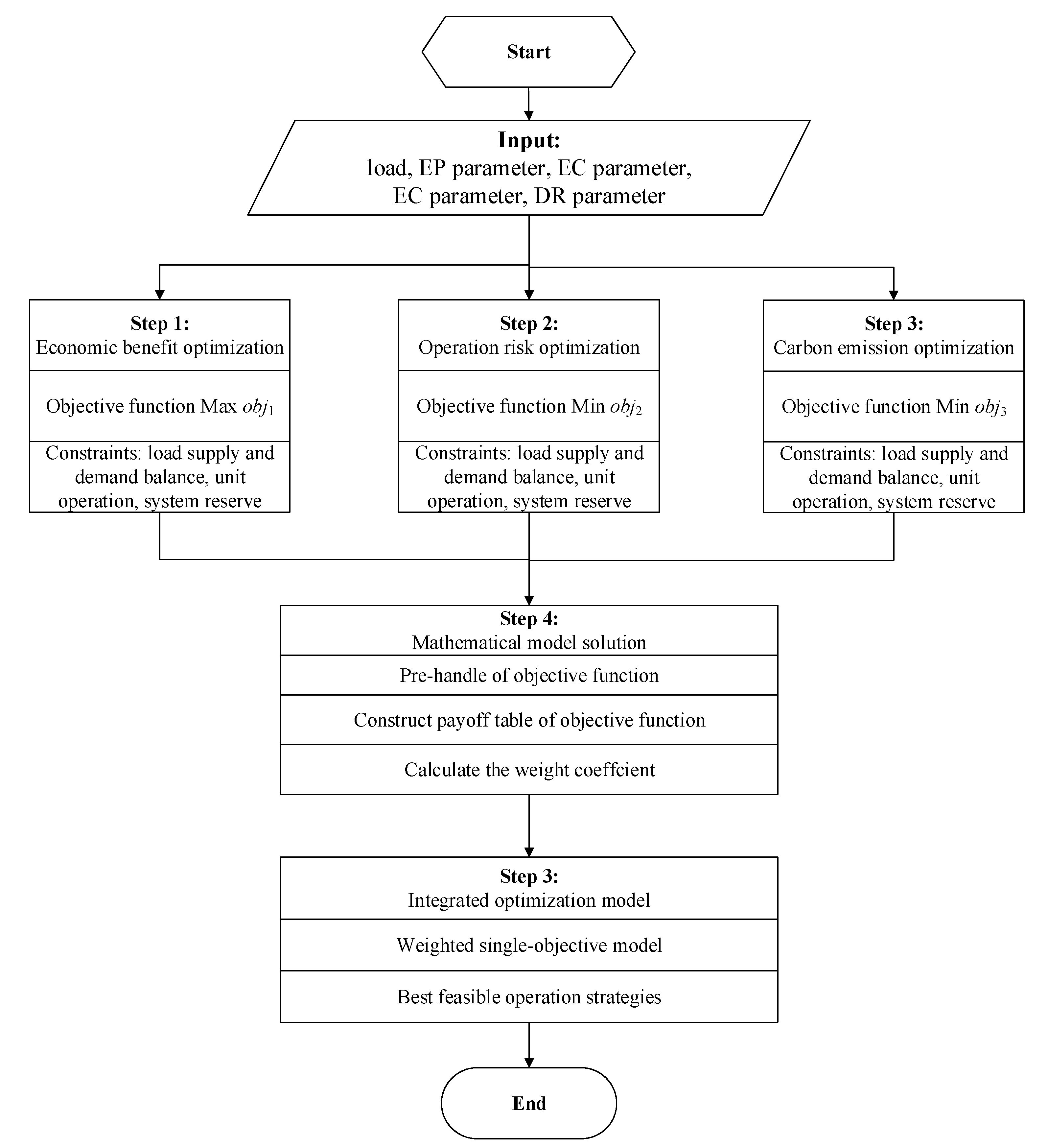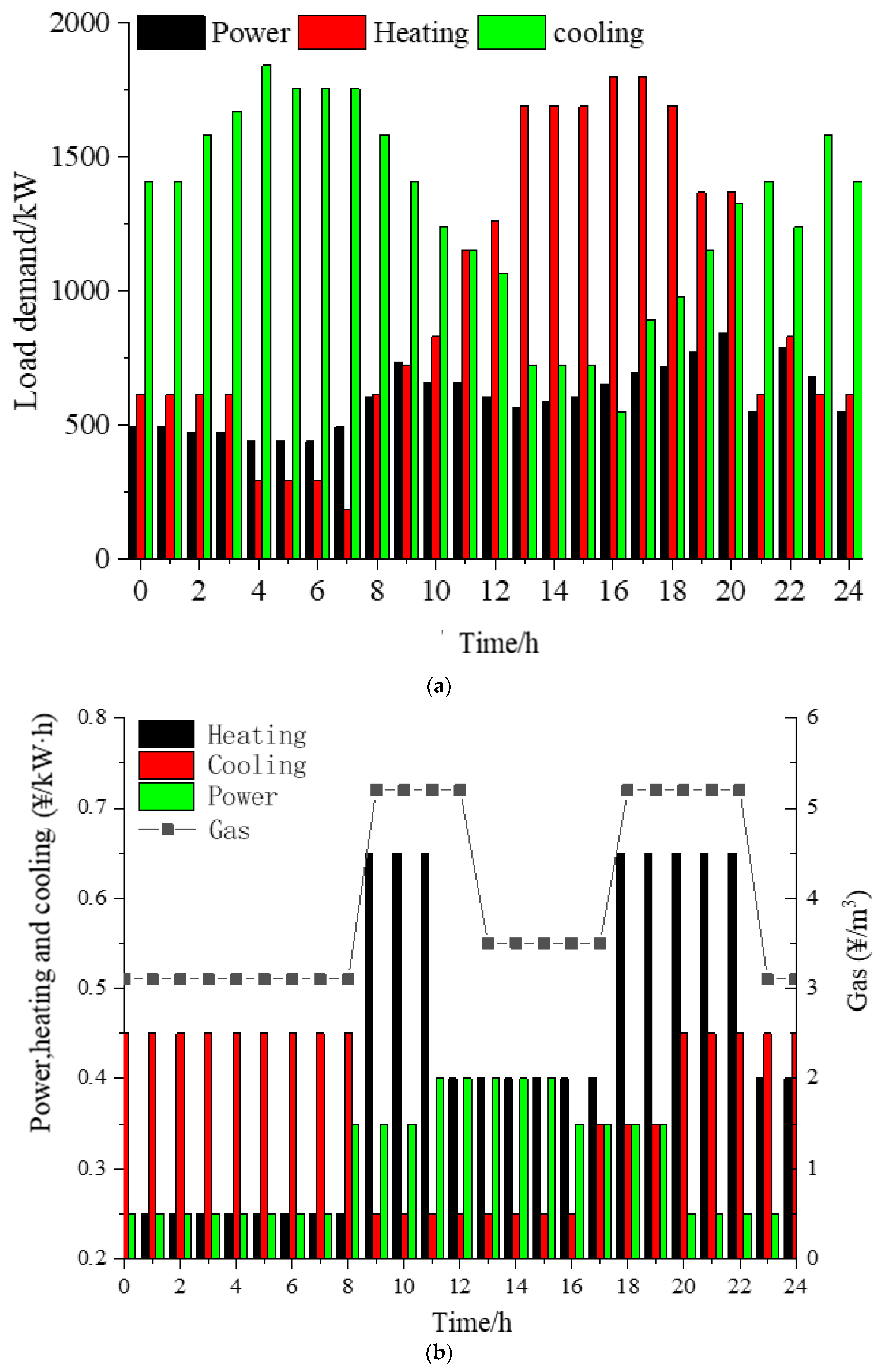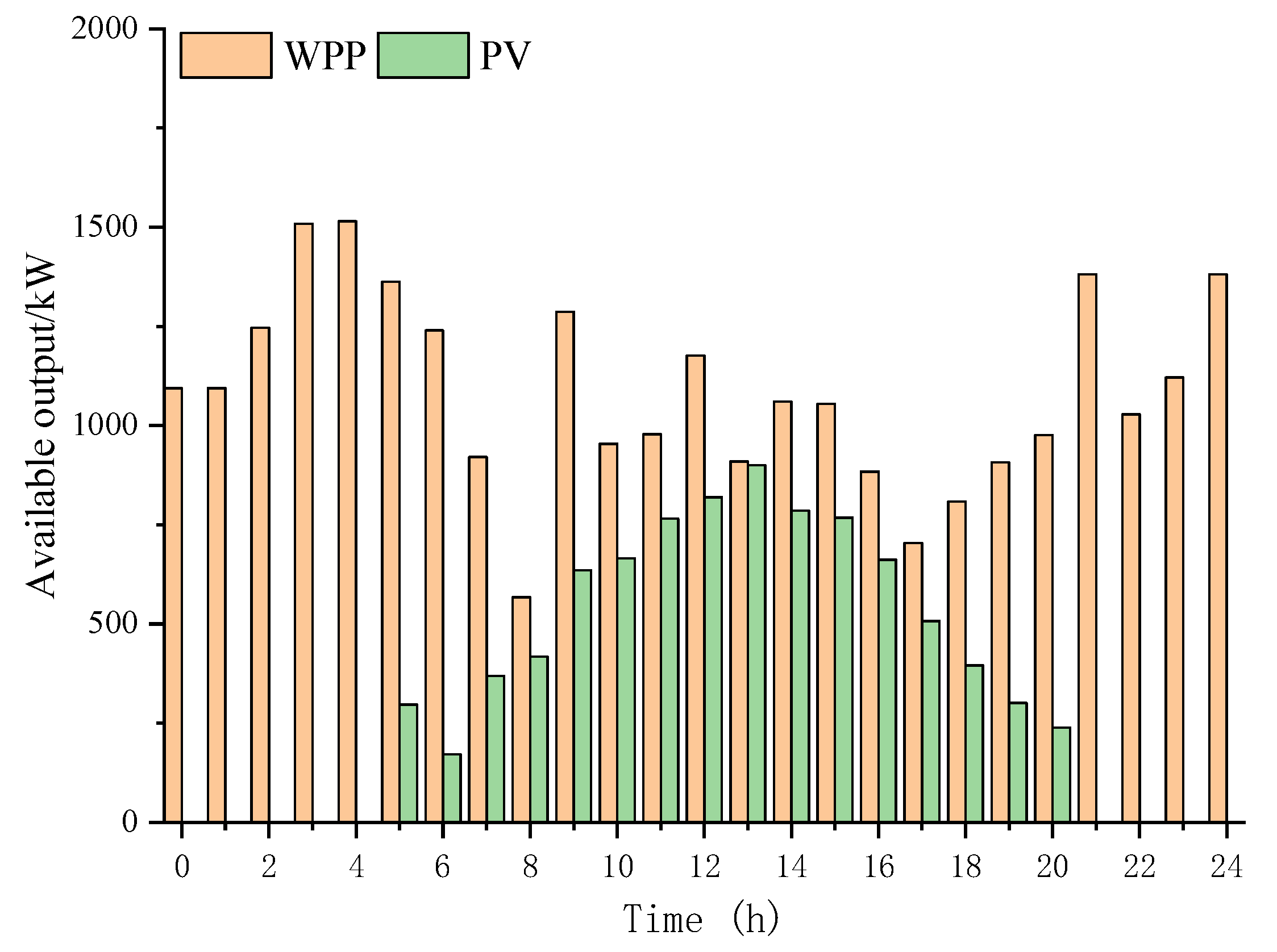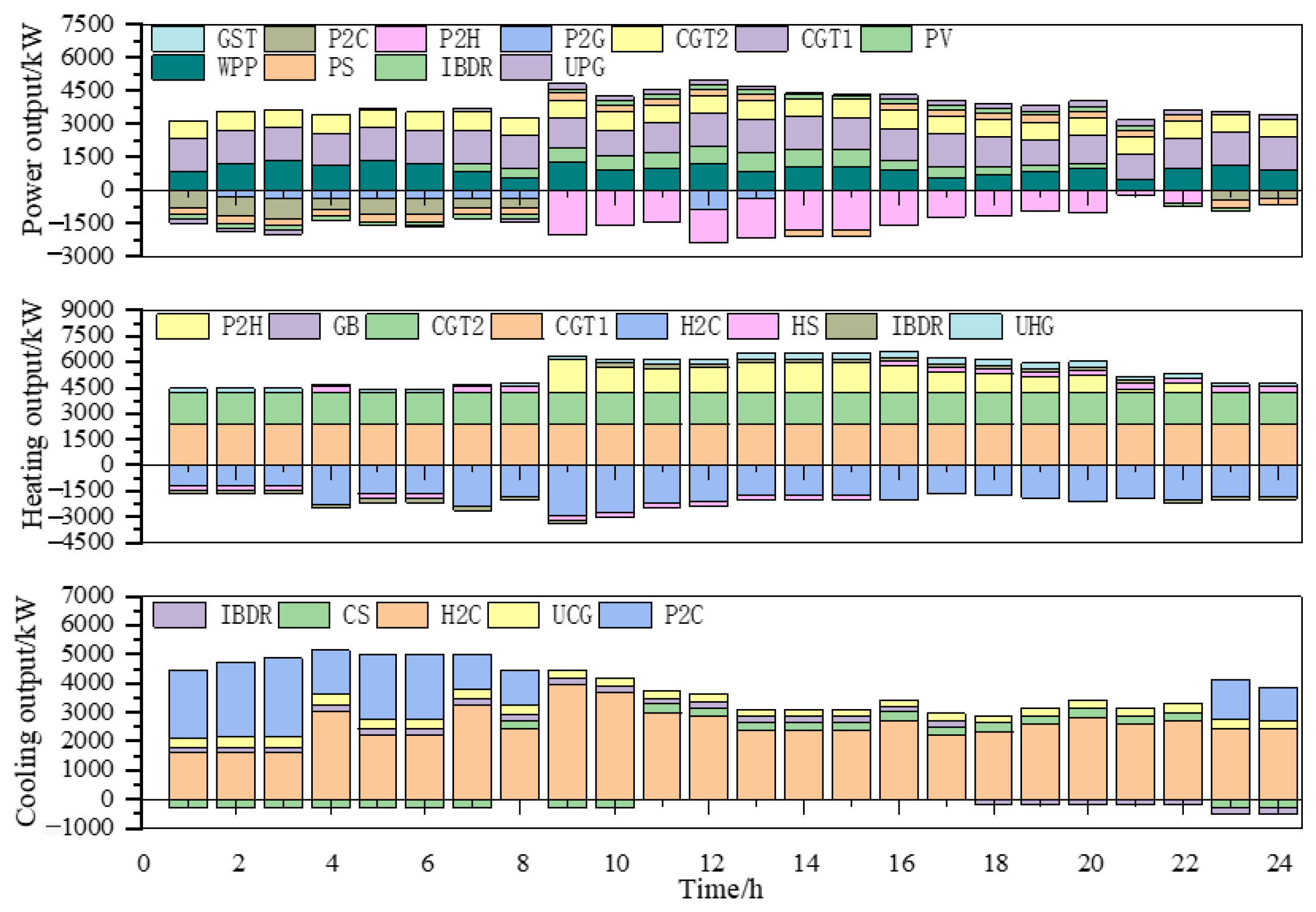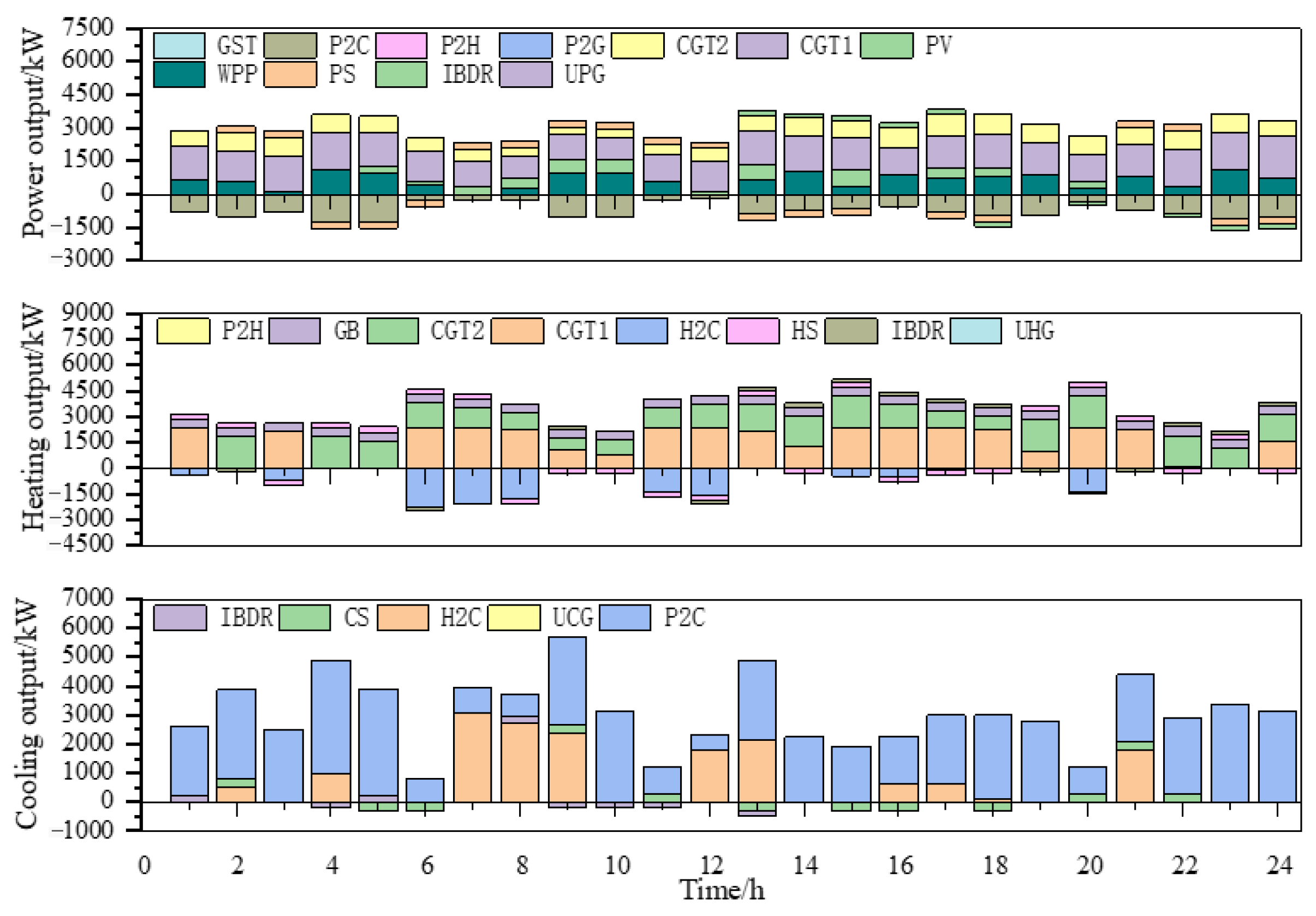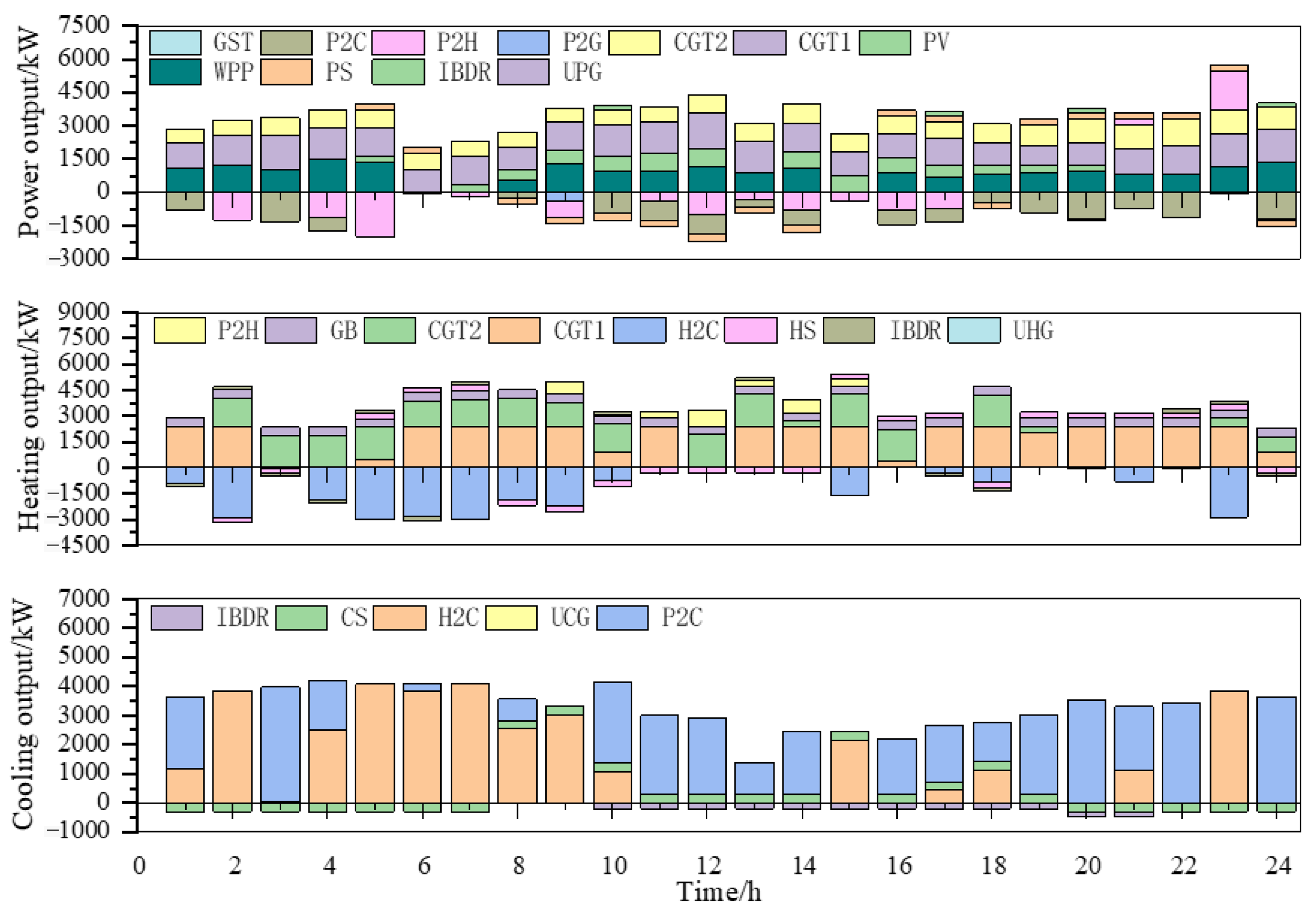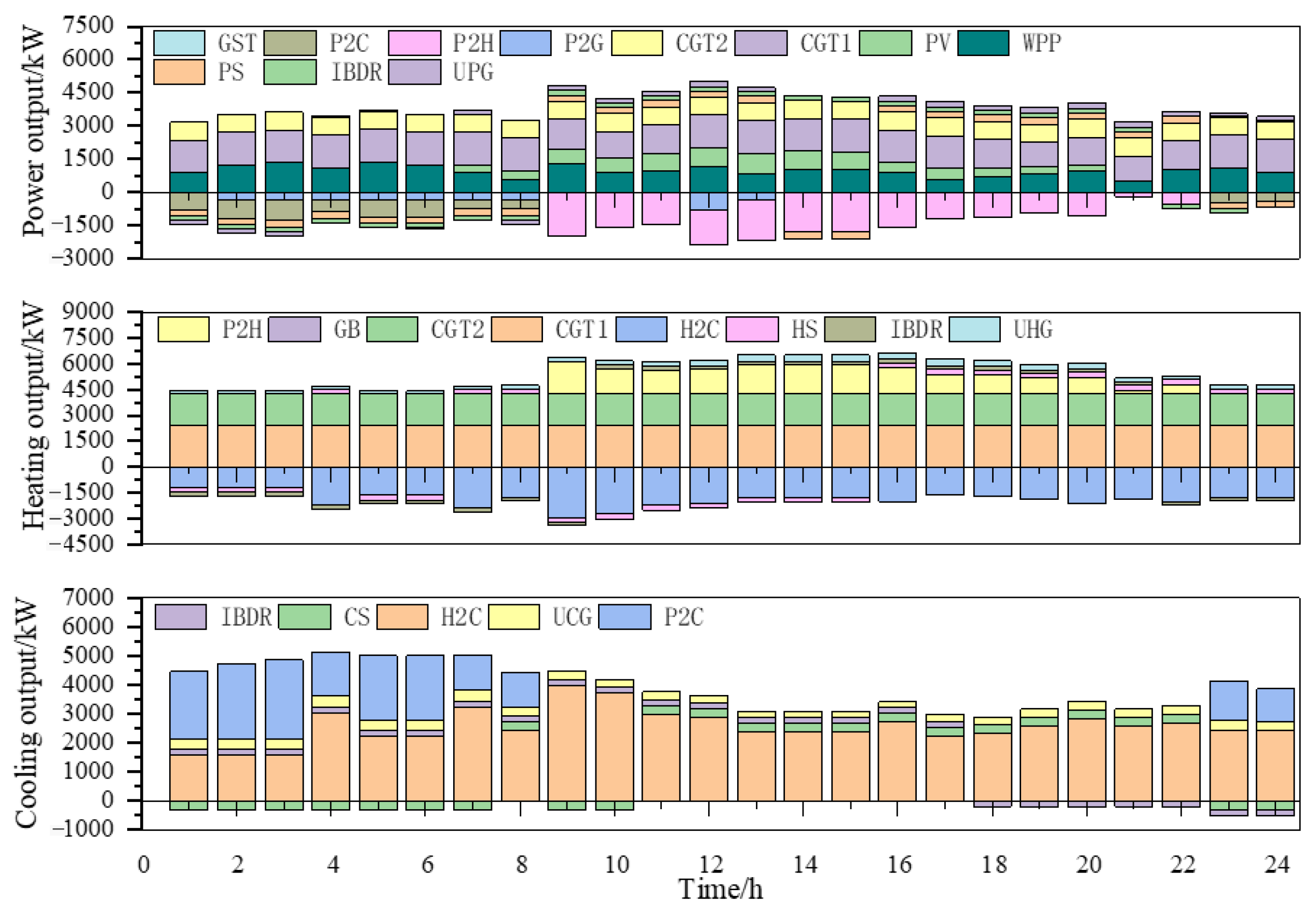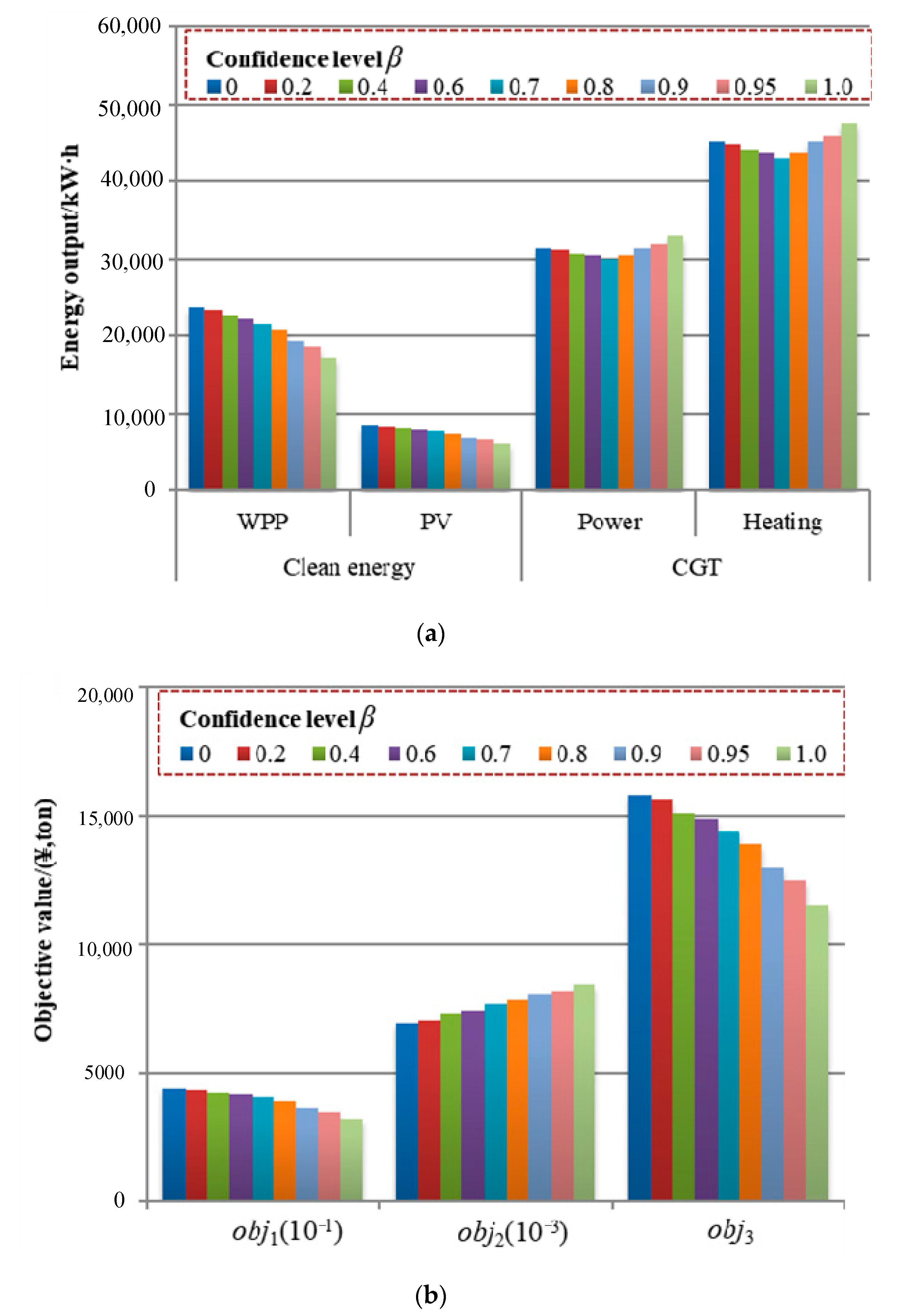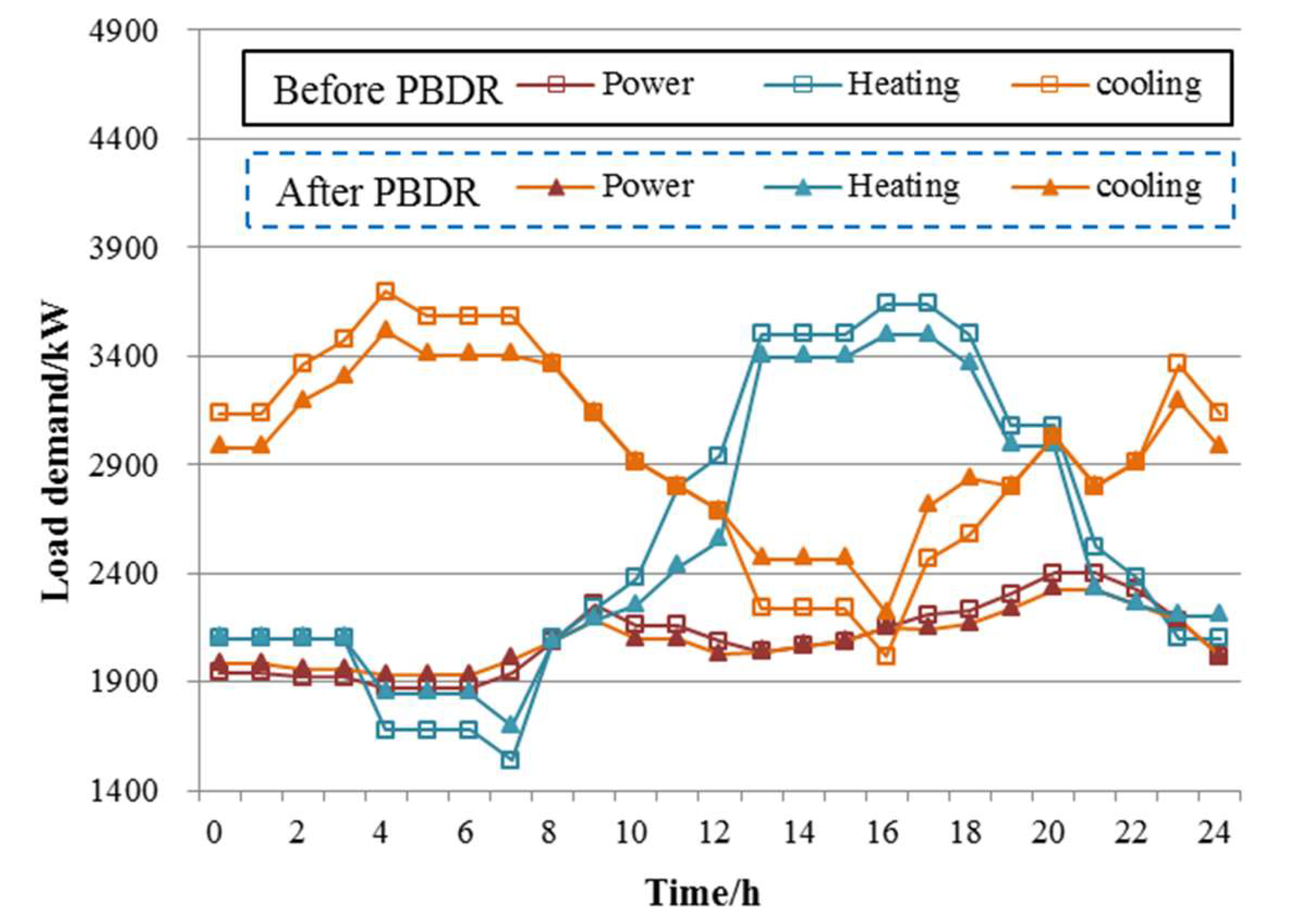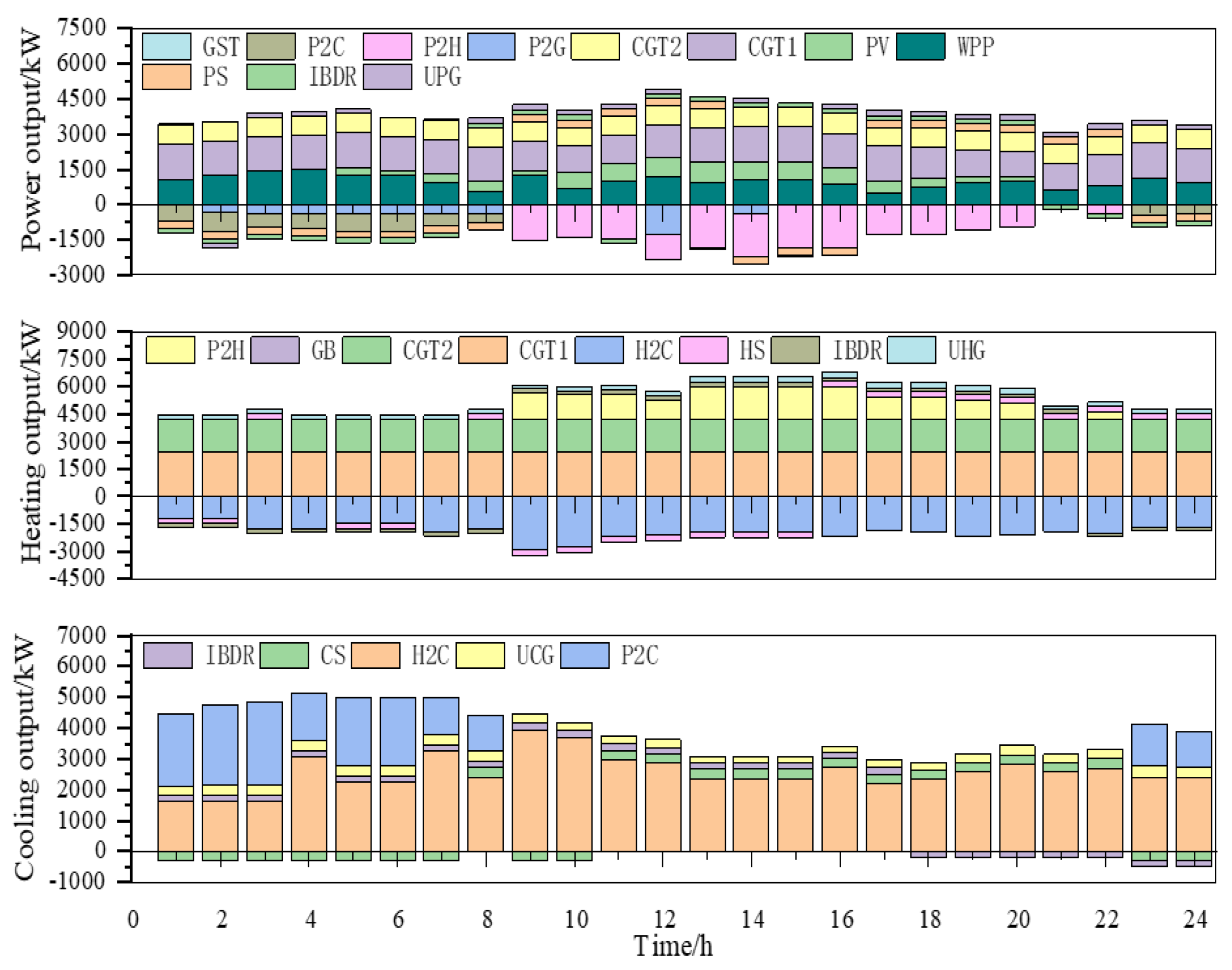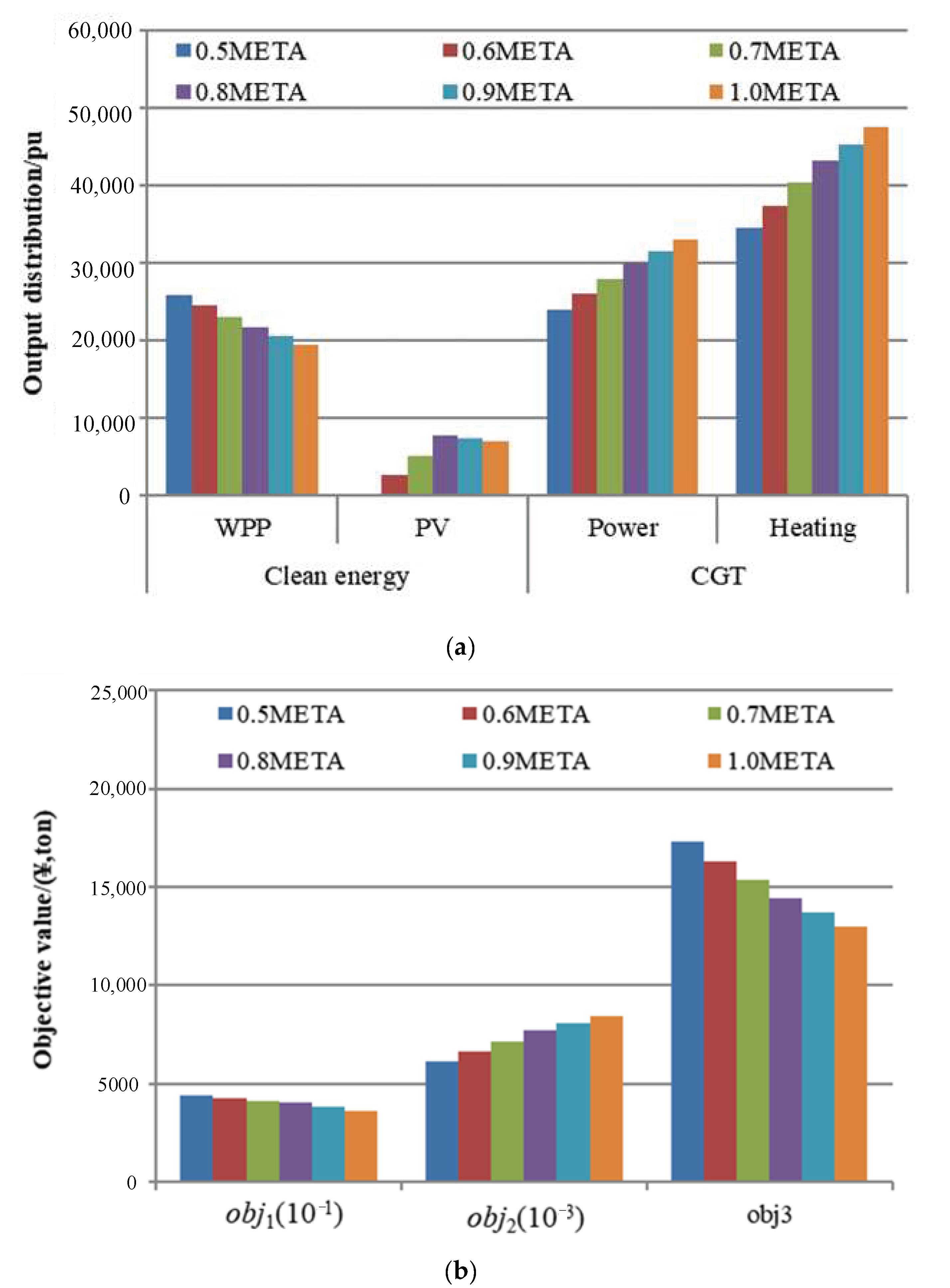1. Introduction
Increasing energy demands, energy crises, and environmental pollution mean that energy utilization efficiency improvement, pollution reduction, and environmental sustainability are popular research topics. The concept of the “energy Internet” has integrated different types of independent systems, such as power, heat, and gas, thus solving the problems of low utilization efficiency due to the independence [
1]. However, technical barriers and closure of traditional energy industries are current challenges for the large energy Internet [
2]. A micro energy system (MES), as an extension of a micro power grid, will be a terminal energy supply system of the energy Internet [
3], which is conducive to achieving multi-energy complementation and energy utilization efficiency improvement. Hence, it is of great significance for healthy development of energy systems to study MESs.
To date, research on MES has mainly focused on coordinated planning and operational optimization, that is, minimum operational costs or optimal environmental benefits were taken as objectives to optimize the operation of equipment in systems. Reference [
4] studied the coordinated dispatch, operational optimization, and strategies of MES energy management for theorical research. Reference [
5] constructed a two-layer optimization model based on adjustable thermoelectric ratio modes of cogeneration units. The first layer pursued the minimum energy cost and the second layer considered energy efficiency as an objective, thus achieving the efficient and economical operation of a MES. Reference [
6] optimized the operation of a MES with the minimum costs of energy consumption and environment. Reference [
7] introduced carbon credits as a tradeable commodity and pursued the minimum costs of power generation and carbon trading in system operation. Reference [
8] integrated photovoltaics, energy storage, and heat exchangers into an energy hub system of resident load and optimized the operation of a MES by pursuing minimum energy cost. The above papers did not consider uncertainties of MESs, which makes it difficult to ensure the security and reliability of systems.
The uncertainties of MESs are mainly due to wind/photovoltaic power; thus, it is important to study the flexible applications of controllable units, energy storage devices, electric vehicles, and flexible load to solve random changes of wind/photovoltaic power [
4]. Reference [
9] described the uncertainties of wind/photovoltaic power via a robust stochastic optimization method and conducted a two-level dispatching optimization for virtual power plants. Reference [
10] proposed a robust optimization method with energy hubs for energy management considering uncertainties of load demands. Reference [
11] established operational strategies for a MES in the United Kingdom via deterministic planning, two-stage planning, and multi-stage planning methods, considering uncertainty of wind power generation. Reference [
12] solved the wind consumption problem based on the rapid regulation of gas-fired generators. Robust optimization and stochastic programming optimization are popular methods for handling uncertainties. However, the probability distribution on which stochastic optimization depends is not easy to obtain, and robust optimization is characterized by boundary parameters of uncertain factors; thus, selecting an appropriate robust set is usually hard and conservative decision results are obtained.
Solving multi-objective optimization models is also a key problem of MES operation. Generally speaking, multi-objective models are solved by related algorithms, but the introduction of uncertainties and new scheduling objectives increases the complexity of the models. Solution algorithms mainly include traditional solution algorithms and heuristic intelligent algorithms [
13]. The former has difficulties in parameter determination and constraint transformation, which leads to a low degree of optimization [
14], while the latter obtains a better solution set, but when an individual extremum is selected without considering multi-objective programming principles, it is easy to make the algorithm settle on a local extremum, and the search ability is limited [
15]. Reference [
16] solved an energy dispatching problem of a MES via particle swarm optimization and the differential evolution algorithm. Hence, transforming and solving a multi-objective model is a major problem in regard to establishing optimal dispatching strategies of a MES.
Energy dispatching and multi-objective model solving are two popular points of the current research on MESs. However, the analysis of operational risk caused by uncertain factors is absent in current papers. Some papers have handled the uncertainties of wind power plants and photovoltaic plants via robust methods and stochastic optimization methods, but there were either difficulties in information collection and accuracy of probability distribution function or inhibiting effects of optimal solutions by bad influences caused by every element in the set. Other papers solved the models via intelligent algorithms, but the effectiveness is greatly affected when an individual extremum is selected without considering multi-objective programming principles. Based on this, we propose an optimization dispatching model of a MES. The contributions of this paper are concluded below.
(1) The structure of the MES, with energy production, conversion, and storage devices, was designed. Also, an incentive-based demand–response (IBDR) and a price-based demand–response (PBDR) were introduced for optimizing the operation of the MES, and an operation model with uncertainty variables was constructed after uncertainties of the MES were analyzed.
(2) Three objectives, namely maximizing operating revenue, minimizing carbon emissions, and minimizing operational risk were pursued, and the constraints of supply–demand balance, unit operation, DR mechanism operation, and spinning reserve were considered.
(3) A multi-objective solution algorithm for MES optimal operation based on fuzzy satisfaction theory and the rough set method was proposed. Firstly, the objective functions were processed using fuzzy satisfaction theory, and optimal dispatching strategies were established under single-objective functions. Then, a multi-objective input–output table was built and the functions’ weights were determined via the rough set method, thus obtaining a comprehensive dispatching optimization model. Finally, the effectiveness of the constructed model was verified by conducting a case study.
The remainder of this paper is laid out as follows.
Section 2 introduces the core structure of the MES and constructs a probability distribution model with the uncertainties of the MES.
Section 3 establishes a multi-objective coordinated dispatching optimization model for the MES, with the objectives of maximum operating revenue, minimum operational risk, and minimum carbon emissions. In
Section 4, a multi-objective weighting method is established by combining the fuzzy satisfaction and rough set methods to solve the constructed model, thus obtaining a comprehensive dispatching optimization model. Next, data from Longgang commercial park in Shenzhen City are introduced for a case study to verify the effectiveness of the constructed model in
Section 5. Significant findings are concluded in
Section 6.
6. Conclusions
This paper comprehensively considered the operating revenue, carbon emissions, and operational risk as optimization objectives, and constructed a multi-objective coordinated dispatching optimization model. The weights of the objectives were determined using a calculation method based on fuzzy satisfaction theory and the rough set method, thus obtaining the comprehensive single-objective function. Then, data from a MES in Longgang commercial park were introduced for a case study, and the effectiveness of the constructed model and the algorithm were verified. The conclusions are as follows.
(1) A MES can integrate different types of energy, such as wind, photovoltaics, and gas. Power–gas–heat–cooling (multi-type energy) cycle supply is realized via ECD and ESD to synergistically meet different types of energy demands. In particular, WPP and PV have considerable economic and environmental benefits. Their surplus power can be converted into other types of energy via P2G, P2H, and P2C, after meeting power demands, thus realizing cascade utilization of energy. End users participating in the operation optimization of MES via DR realize source–load interaction.
(2) The constructed multi-objective coordinated dispatching optimization model gives consideration to operating revenue, carbon emissions, and operational risk, and the solution algorithm can be used to obtain an optimal balanced strategy for multiple objectives. The objective values of multi-objective comprehensive optimization are close to the mean values of different single-objective optimization scenarios. Since the weight of the operating revenue objective function is the highest, the operational results are biased towards this objective, which indicates that the dispatching strategy of MES is more balanced.
(3) Sensitivity analysis results indicate that a reasonable confidence setting is an effective tool for different decision makers to make dispatching strategies for different interests, and PBDR and MTEA are indirect factors that affect the energy supply structure of a MES. A decision maker prefers risks when the confidence is less than 0.6; confidence within (0.7,0.85) indicates a decision maker is sensitive to risks; and a risk averter, who refuses to take any risks, is indicated by confidence of 0.95 or higher. PBDR is introduced to smooth load curves. MTEA limits energy supplies of CGT, GB, and UEG to increase the chances for WPP and PV on-grid connection, thus optimizing the energy supply structure of the MES.
